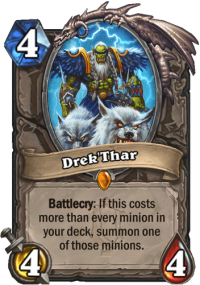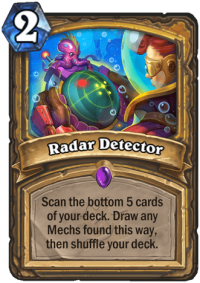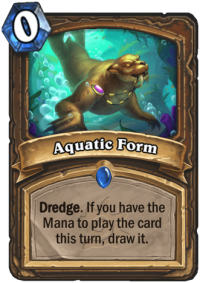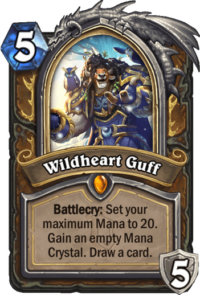The first Voyage to the Sunken City balance patch is coming tomorrow, and it is not a moment too soon. The new expansion, combined with the annual Standard rotation and the new Core Set, was initially well-received. Things felt fresh because many of the most powerful cards rotated out of Standard format. However, it did not take long for the meta to get figured out.
In just two weeks, Voyage to the Sunken City meta has largely settled into three decks: Ramp Druid, Aggro Demon Hunter, and Quest Warrior. In the final stages of the Legend climb, these three decks are more than 70% of the field.

Well, the nerfs are coming. Ramp Druid and Quest Warrior are both hit by two nerfs, while Aggro Demon Hunter… Oh right, Aggro Demon Hunter is not touched at all. With the current decklists, Aggro Demon Hunter loses to control decks (Control Warrior, Control Paladin, Charge Warrior) and beats pretty much everything else. Quest Hunter puts up an even fight, but that’s about it. There is some hope that with less oppressive Ramp Druid and Quest Warrior, other decks can be changed to better fight against Aggro Demon Hunter. I’m not too hopeful about that.
A major reason it is hard to build new decks in Voyage to the Sunken City is the overall set design. There were lots of new decks to play right at the start of Sunken City. People were excited. The game felt smooth, the decks curved out nicely. It was perhaps too smooth for such early days. In fact, many of the classes got such synergistic sets that it is nigh impossible to break free of them to explore other options.
Deep Tribal Synergies
Mech Mages, Mech Paladins, Pirate Rogues, Murloc Warlocks, and Quest Pirate Warriors were everywhere at the start of the expansion. These decks got a lot of support in the new set, to the extent that the set could hardly support any other decks for the classes.

An even bigger issue is how deep the tribal synergies are. Take Radar Detector, for example. A two-mana spell that can draw up to five cards, but it only draws Mechs. The more non-Mechs you put in your deck, the weaker Radar Detector becomes. Bubblebot gives your minions sweet buffs, but only if they are Mechs. Swordfish is a powerful weapon, but only if you can Dredge a Pirate with it. Azsharan Scavenger and Chum Bucket can give your minions powerful buffs, but only if they are Murlocs.
For the majority of these mechanics, you want around 18-20 synergy cards in your deck. With 18 Mechs in your deck, Trench Surveyor draws a card 95% of the time. With 20 Mechs, you get to draw 97% of the time. Cut the number down to 15, and you’re drawing only 89% of the time. This is a mechanic you want to activate every time you play the card. Cutting just a few Mechs from the deck drastically lowers its reliability to the point where it is not worth using anymore. From there, the whole tribal deck concept breaks.
To build one of the tribal archetypes from Voyage to the Sunken City, you need to use almost every available tribal minion. This is why the decks were so smooth already on day one. It is also why there is so little that you can do with them afterward. The scope of refinement is limited, and the scope of new innovation is even more so. Only Pirate Rogue has managed to escape some of its chains by completely cutting its big payoff card Pirate Admiral Hooktusk and focusing on a pure aggro strategy. I’m not sure if that development is even a desirable one, as Hooktusk was the most unique thing about the entire archetype. At least the deck became cheaper to build with one less Legendary card to worry about.
Dredge Is No Scry
The new mechanic in Voyage to the Sunken City, Dredge, was also received with great interest. Dredge allows you to take a look at the bottom three cards of your deck, and pick one to move to the top. Many Dredge cards also do other things to the card you choose, such as buff it or draw it directly to your hand if it fulfills certain criteria.
The mechanic has been compared to the Scry mechanic in Magic: The Gathering. With Scry (n), a player looks at the n top cards of their deck and puts any of them at the top or bottom in any order. For example, if you Scry (3), you look at the top three cards of your deck.

The major difference between the two is where you look. When you look at the top of your deck, the cards that are offered to you change every turn. When you look at the bottom of your deck, you will be offered the same options unless you can put cards to the bottom of your deck or shuffle your deck.
While this may seem like a minor difference, Scry is a far stronger mechanic in practice. Scry gives you more control over your draws and relies less on synergies. Dredge cards are usually only useful if you can fulfill their additional requirements so that you get to do more than put the card on top, and because you are looking at the relatively unchanging bottom of your deck, you need to fill your deck with synergistic cards to make sure your Dredges work as you want them to.
By far the most successful Dredge card in the set is Druid’s Aquatic Form: it is basically just a free discovery from your deck that requires no other synergies to function. As long as the deck contains no other Dredge cards, the drawbacks of Dredge never happen.
Dredging once is often useful. Dredging twice is less so. Maybe Hearthstone games are just not meant to last long enough to Dredge twice or more.
Is There Anything New Coming?
Even with the nerfs right at the doorstep, it is hard to see what more Voyage to the Sunken City has to offer.
 There are a few general mechanics and power cards that carry all the meta decks:
There are a few general mechanics and power cards that carry all the meta decks:
- Druid has the ramp mechanic and Wildheart Guff
- Demon Hunter has Drek'Thar and Kurtrus, Demon-Render
- Paladin has Lightforged Cariel: Control Paladin is basically just a deck that supports Cariel
- Warrior has Raid the Docks
- Hunter has Defend the Dwarven District
- Priest has Switcheroo (about the be nerfed and dead)
- Shaman has Snowfall Guardian and Bioluminescence
For the most part, the meta is Hero cards, Questlines, and Drek'Thar. Burn Shaman with Bioluminescence is the most innovative Sunken City deck we have seen so far, and that is not a compliment to the set.
Control decks are about to get a little stronger with the nerfs and they are the natural counter to Aggro Demon Hunter. That, in turn, may open up more space for midrange decks. The top midrange decks are the tribal synergy decks and Quest Hunter. That could end up in a rock-paper-scissors meta between the three archetypes.
Balance changes cannot polish something special from a set with deep tribal synergies and a lackluster sunken/Dredge mechanic that provide only a few building blocks for anything new beyond the decks they were designed for.

“Dredge cards often do something else” haha… demon hunter 5/2 for 5 only dredges with nothing else on top when Rogue gets 4/3 +2 attack buff for 3 mana. Interesting balancing choices Blizzard…
“To build one of the tribal archetypes from Voyage to the Sunken City, you need to use almost every available tribal minion”
After the first set of the year, the card pool is always smallest. If the next expansion brings more mechs, murlocs, nagas and rogue pirates, tribal decks will have more options to choose from